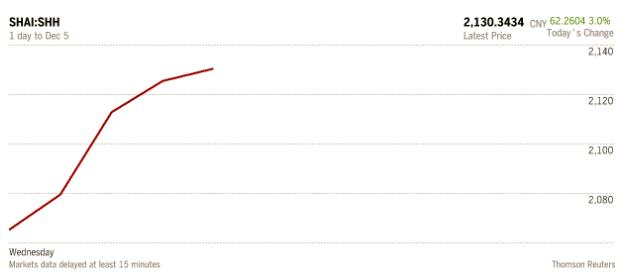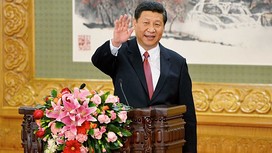
Cross posted from FTAlphaville.
What made the Shanghai Composite, after many months of mostly tracking downwards, do this today?

Was it this?
(Reuters) – China’s economic growth may quicken to 8.2 percent in 2013 from an expected 7.7 percent this year in response to official growth-promoting polices, but downside risk remains from global uncertainties, the Chinese Academy of Social Sciences (CASS) said on Wednesday.
Maybe… although there had already been a forecast of 8.4 per cent made last month which didn’t seem to make A-shares rocket. And the Shanghai Composite began to rise yesterday, though not as sharply as today.
It can’t be about the HSBC China services PMI, because that was not so great — 52.1 compared to 53.5 in October.
Oh! Maybe it’s this…

And more specifically (at least, according to Bloomberg), this:
China will further carry out the country’s regional development strategy by accelerating development of economically underdeveloped regions, it said.
That’s from the Xinhua report of the Chinese politburo meeting yesterday, the first since the appointment of Xi Jinping as the party’s leader last month.
A lot of the coverage of the meeting focused on Xi’s pronouncements that there will be no more flower arrangements, red carpets, and “empty talk”. Official feasts and ribbon-cutting ceremonies are to be reduced. We’re not sure what this means for images of totalitarian banality, but — oh joy! — the publication of news stories “with no content” is now also banned.
However we’re here for the financial stuff. And the big question is — now that a stimulus-enlivened Q4 growth upturn seems well and truly under way — what will 2013 bring in terms of economic policy? Because the consensus is for growth of around 8 per cent, but Capital Economics says media reports indicate the target for 2013 will again be per cent.
Something niggles about this. Sure, in the past the official GDP growth target has nearly always been exceeded, although it’s notable that that didn’t happen in the third quarter of this year, despite the approaching leadership handover.
As we explained a couple of weeks ago, we are increasingly keen on the outlook from Zhiwei Zhang of Nomura, despite initially being sceptical of his forecast Q4 2012 growth of well above 8 per cent (8.4 per cent, to be precise). He was confident about local stimulus spending projects back in September when most strategists were dismissing them as being already announced, or lacking financing.
His views are different, however, beyond this year. Zhang has below-consensus forecasts for 2013 (7.7 per cent) and thinks China no longer has potential growth of much higher than 7 to 7.5 per cent.
Zhiwei believes there were a couple of indications from the politburo meeting yesterday that the there won’t be a large-scale stimulus in 2013:
First, the Politburo believes the economy has stabilized, which lowers the urgency for new stimulus. Second, the new leaders did not talk about pushing new investment projects. Instead they emphasized “promoting new sources for growth on the consumption side” and “controlling industries with high energy intensity and over capacity”. Many investors asked us if policy will be changed after the leadership transition in China and if there is another round of stimulus to push growth to rebound throughout 2013. We think the news release from this meeting suggests such expectations are unlikely to materialize. We maintain our view that the current recovery cannot be sustained throughout 2013 and growth will likely decline in H2 2013 to 7.2% when inflation rises and the policy stance shifts toward tightening.
Is Zhiwei reading too much into it? Here’s some other parts from the Xinhua report of the meeting, which the markets apparently either ignored or interpreted differently from Zhiwei:
Chinese authorities will put “enhancing quality and efficiency of economic growth at the center” next year and they will deepen reform and opening-up, as well as step up efforts to pursue growth driven by innovation, it said.
More efforts are needed to improve macro economic control, boost domestic demand, adjust the economic structure, improve people’s livelihoods, and add vitality to the economic development, according to the statement.
China should also work to maintain stable consumer prices and realize continuous and healthy economic development as well as social harmony and stability, the statement said.
Efforts should also be made to promote a stable increase of investment, optimizing investment structure, boost agriculture production, advancing urbanization, optimize foreign trade structure, and push forward reforms in key sectors, it said.
Still, it’s perhaps a little early to be conclusive about how things will pan out in terms of economic rebalancing, and the inevitable slowing of growth that this entails. As Mark Williams of Capital Economics told Bloomberg, it’s still not clear how willing China’s new leaders are to take on the difficult decisions relating to rebalancing.
The party is holding its economic work conference this month, which will probably reveal more about the policy direction the government will take.
But we wonder, can China achieve 8 per cent growth that many seem to be counting on, without continuing stimulus spending on infrastructure?

